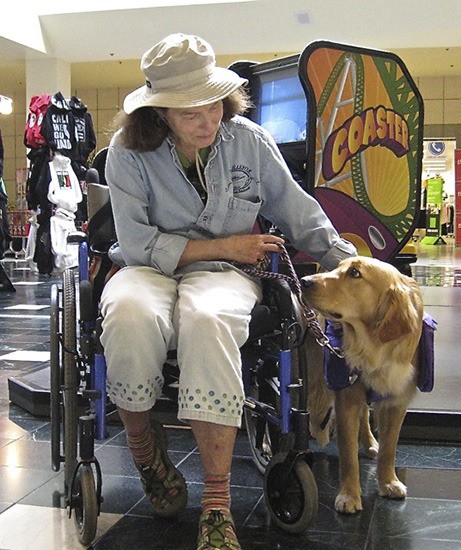Service dog trainer Leslie Liddle spoke at the May 25 Unitarian Fellowship service describing her connection with the dogs she works with. She shares these thoughts here.
I’ve always been fascinated with wildlife, which was encouraged by my parents who were both artists, one a musician and the other a painter. We spent our summers outdoors with my father fishing, my mother painting, and my brother’s and my wading through streams and exploring every little wild thing – be it a crawdad, mushroom, beetle, or milkweed pod. It was obvious to me that my family was happiest when we were together in the New York Adironack country, but we were highly stressed when we were not in that outdoor country and when my father was hard at work.
What have I learned from my considerable time living with nature and a good variety of animals? We are all made of the same cloth. Within each one of us, whether we are a human, a dog, a dolphin, a raven or an old growth fir tree, lies the inherent ability to bond to one another and to form a profound connection. I have learned at first meeting with wild animals, or practically every living thing, that it is most important to stop, quietly relax, tend to myself, but at the same time and very importantly – to listen and watch for signs that the object of my interest at some point shows interest in me – or not.
If I do get a sign of interest, that will help me to creatively move toward connection. Then begins a slow and careful dance. There is no faking it. It is absolutely a two-way street. Once a safe connection is made, in which no one is devoured – and that connection with animals seems to often happen during a night spent in one another’s vicinity – a potentially deep bond between species can occur and be just as powerful as that within a single species, human or otherwise. Moving from curiosity to respect of one to the other is critical. And in my experience, the essential connection, the flicker of something called love, is born.
Although I earned a degree at the Assistance Dog Institute specifically for service dog training, everything I have really learned in terms of deep communication with dogs has been taught to me by observation and interaction with dogs themselves. I set very clear boundaries of personal respect. At the same time, my intention is that I deeply care for, like and enjoy each dog, and that feeling must be mutual. Some behaviors work, some don’t. I am teaching dogs skills that can help them to get along well with other dogs and people so they can be even more basically better and smarter than they already are – and we are still learning a lot about that process. Often a dog is difficult because effective inter-species communication has not happened, and a team is really at frustrating cross purposes. The point I try to make in dog training is to reinforce a dog’s confidence in himself, to enhance the handler’s effective communication, to show clearly (with precise timing) what needs to happen, to challenge and give a dog the exciting opportunity to choose what works and then to praise generously for “right” action.
I see dog training as a trusted and partnered dance of synchronized voice, timing, rhythm and motion. Because dogs have keen senses and are so highly tuned, the more effectively a trainer can do this dance, the quicker dogs are able to synchronize and learn new skills.
“Whispering” is a form of empathic understanding. It is a result of the experience of opening up one’s attitude of willingness, taking the time to simply observe and holding the desire to interact kindly with another species. “Whispering” is the gentle entrance into the “source” we living beings all share and the effective use of that as language for communication.




